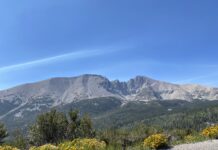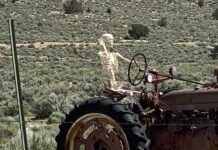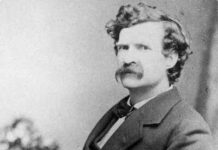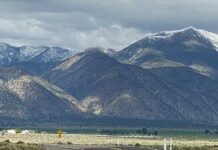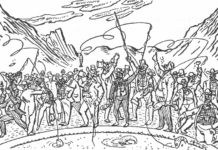I don’t quite know how to introduce the strange place in the desert we visited early in July. 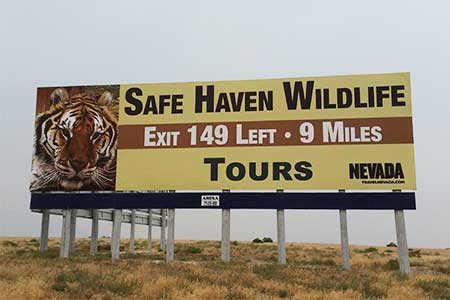 It is only ten miles off Interstate 80 at Mill City but far removed from what you expect to find in the Buena Vista Valley. It’s called Safe Haven Wildlife Sanctuary. You’re welcome to visit, but call ahead first — 775-538-7093 — to make sure the gate is open. From Mill City drive south on Nevada 400; about 10 miles along you’ll pass a small tan cinderblock structure on the right and then take the first road to the right, maybe a quarter mile farther on.
It is only ten miles off Interstate 80 at Mill City but far removed from what you expect to find in the Buena Vista Valley. It’s called Safe Haven Wildlife Sanctuary. You’re welcome to visit, but call ahead first — 775-538-7093 — to make sure the gate is open. From Mill City drive south on Nevada 400; about 10 miles along you’ll pass a small tan cinderblock structure on the right and then take the first road to the right, maybe a quarter mile farther on.
This graded gravel road leads straight to the base of the mountains, but the marked turnoff to Safe Haven is about a half-mile along. Pass through the gate as pre-arranged and continue to the small compound that is headquarters for the fenced and double-gated retirement community for wild animals unfit for the wild.
 It is not a zoo, it is a refuge. For a variety of reasons — defanged or declawed, born in captivity — the animals here can’t survive in their natural habitat. The tigers, the bears, the lion, the coyotes and the various cats will live out their lives here.
It is not a zoo, it is a refuge. For a variety of reasons — defanged or declawed, born in captivity — the animals here can’t survive in their natural habitat. The tigers, the bears, the lion, the coyotes and the various cats will live out their lives here.
The extreme fencing is one of many requirements imposed to ensure the animals don’t wander off. The enclosures are quite spacious, furnished with shade and climbing platforms, and constantly overseen and maintained by a paid staff of two and as many as five interns depending on the season.
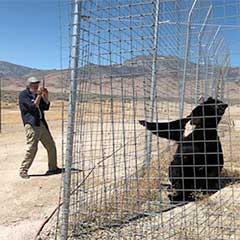
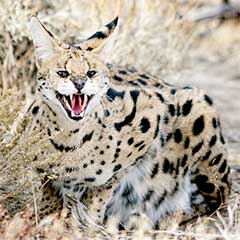
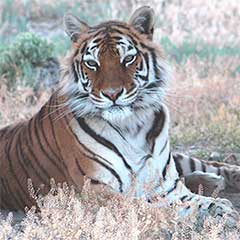
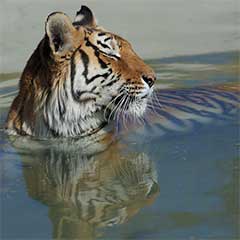
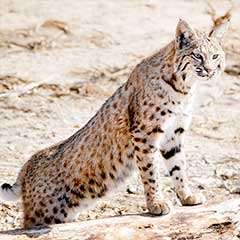
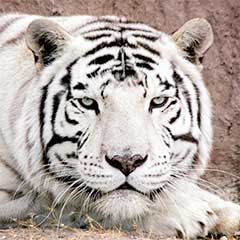
Safe Haven ToursTours of the grounds are available seven days a week, at 9 am, 11 am or 1 pm depending on the season, by appointment only (775-538-7093).
|
Demanding as the care and feeding of the residents can be, raising the money that pays for it isn’t easy either. 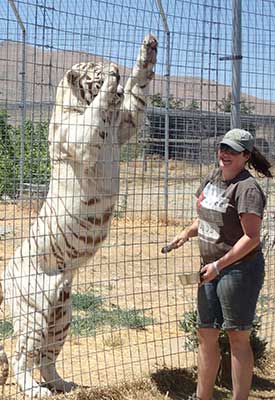 Corporate sponsors include mining companies active in the area and a number of foundations that have supported the effort since it relocated here in 2006. In addition to the daily tours described at right, fundraising events include a Full Moon Tour just completed (Snores ‘n’ Roars), and a Tee off for Tigers golf tournament held at Reno’s Arrowcreek Country Club on Saturday, September 29.
Corporate sponsors include mining companies active in the area and a number of foundations that have supported the effort since it relocated here in 2006. In addition to the daily tours described at right, fundraising events include a Full Moon Tour just completed (Snores ‘n’ Roars), and a Tee off for Tigers golf tournament held at Reno’s Arrowcreek Country Club on Saturday, September 29.
This story began more than 20 years ago when Lynda Sugasa was driving in rural Illinois and saw a little raccoon lying beside the road. She stopped and began a frustrating search for help that taught her how little help is available for injured wildlife, and how hard it is to find.
She eventually located an animal rehab center where the raccoon was taken in and by the time it was released back into the wild, Lynda had enrolled as a volunteer. There she helped heal and rehab the local wildlife brought in for treatment: orphaned fawns, injured opossums and flying squirrels, all kinds of critters to be restored to health and released back into the wild.
| As America celebrated the 4th of July 2016, four African servals and two caracals, approximately 2-6 months old were seized from individual who had allegedly intended to sell them illegally as pets. |
In 1998 Lynda and her husband David established the 5-acre Safe Haven Wildlife Sanctuary in Illinois, and for the next eight years they cared for and reintroduced hundreds of native fauna, and took in an increasing number of abandoned and surrendered exotics. These can’t be reintroduced to their original habitats even if they haven’t been declawed and/or defanged by previous owners, because they’ve become habituated to humans and lack appropriate fear, or they’ve never learned survival skills in the wild.
The required security improvements and the space limitations impinged on the operation. David Sugasa had been baptized in Winnemucca and has relatives in Lovelock; his awareness led them to Buena Vista Valley.
In the dozen years since they arrived, Lynda, David, the Board of Directors, the interns and volunteers have made the Refuge into a highly respected, fully licensed and accredited facility that receives rescued animals from all over the USA and around the world. Neighboring ranchers, wary at first, have become enthusiastic supporters.
Safe Haven’s suggestions for necessary animal rescues1. Prepare a container. Place a soft cloth on the bottom of a cardboard box with a lid, a cat or dog carrier will work as well. Make sure there are air holes. For smaller animals, you can use a paper bag with air holes punched in. |
Make a visit to Safe Haven, maybe you will become a supporter too.
Editor’s Choice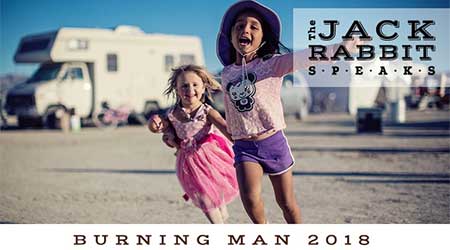 Bringing Kids to Burning Man
|
Five Years Ago in the NevadaGramSince late in 2010 the necessity of defending the Virginia City National Historic Landmark against surface mining has meant interrupting the NevadaGram from time to time. Compared to the other frustrations and annoyances we and our neighbors have been subjected to since the arrival of CMI, this is minor but it still leaves gaps in the story. I’m now filling these gaps retroactively by writing Updates about the open pit mining situation here. I started in January, working forward to catch up, and backward as I can find the time (I have the complete CRA archive of correspondence and documents to draw from). The Updates are all presented below, most recent at the top. |
Overheard at Cafe Del Rio in Virginia City: If you break your neck, if you have nothing to eat, if your house is on fire, then you’ve got a problem. Everything else is an inconvenience. Life is inconvenient. Life is lumpy. A lump in the oatmeal, a lump in the throat, and a lump in the breast are not the same kind of lump. One needs to learn the difference.
Ten Years Ago in the NevadaGram
Elko: the coolest little city in the world. John had spent 15 months as a platoon leader in Baghdad, and this excursion into the sagebrush was our first chance to spend time together since his return to the States. We’d spent our second day traveling from Winnemucca by way of Golconda, Midas and Tuscarora, and we were ready for a taste of city life. And what a tasty little city Elko has become! It’s a favorite of mine, right up there with Paris, Prague, and Pahrump.
Upstairs at Capriola’s: old Elko. Elko still shows its cowtown roots everywhere you look, but it’s also showing cosmopolitan touches it never had before. The best place to see this for yourself is on the sidewalk at Fifth and Commercial Street. Capriola’s is on the same corner it has occupied since time immemorial, selling everything for the rancher, cowboy and dude. Downstairs is a rich display of snap-button shirts, broad-brimmed hats, tooled belts and purses, and precious metal doodads ranging from belt buckles to spurs. Upstairs is the rope and saddle shop and a small museum dedicated to the shop’s heritage which dates back to the famous J.S. Garcia store established in the late 19th century. This is the Elko your grandfather would recognize, and you’re welcome to come up and have a look. |
What They’re saying About Us: “Let’s make Hoover Dam into a giant battery.”
15 Years Ago in the NevadaGramThe First Annual Festival in the Pit was a huge success, and Battle Mountain is still experiencing the bliss.
|
Parting Shot —



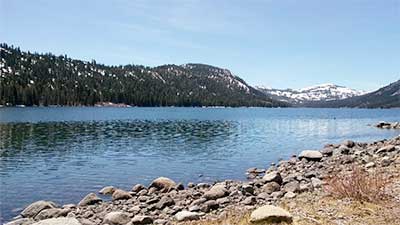
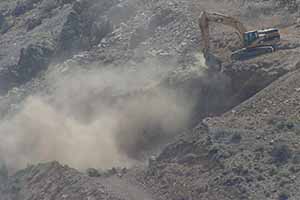
 My son John and I arrived in
My son John and I arrived in 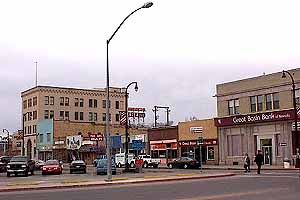
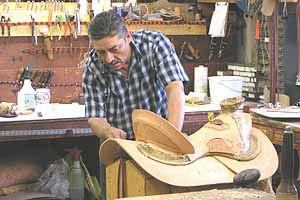
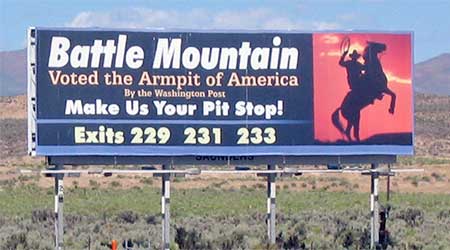 This flamboyant and flourishing offspring of the Ultimate Insult and the Old Spice deodorant company, drew several thousand visitors over its three-day run. Visitors enjoyed a varied schedule of activities and events at Elquist and Lions Parks and informal activities at the Owl Club and other hot spots around town. Hot spots in Battle Mountain? Yes, and a big parade. Gene Weingarten, author of the
This flamboyant and flourishing offspring of the Ultimate Insult and the Old Spice deodorant company, drew several thousand visitors over its three-day run. Visitors enjoyed a varied schedule of activities and events at Elquist and Lions Parks and informal activities at the Owl Club and other hot spots around town. Hot spots in Battle Mountain? Yes, and a big parade. Gene Weingarten, author of the 